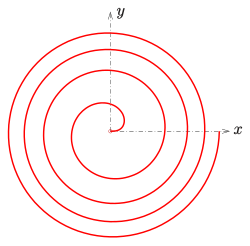Cyclotron
A cyclotron is a type of particle accelerator invented by Ernest Lawrence from the University of California, Berkeley in 1930.[1] It accelerates charged particles by whirling them in a circle. The first cyclotrons were the size of a hand. Some modern circular accelerators use a circle as wide as a city.
Cyclotrons use perpendicular magnetic field to bend electrons and particles through into a semicircular path by an applied electric field. The applied electric field accelerates electrons between the "D" electrodes(also called "dees") of the magnetic field region.
The accelerating electric field reverses just at the time the electrons finish their half circle, so that it accelerates them across the gap. With a higher speed, they move in a larger semicircle. After repeating this process several times, they come out the exit port at a high speed.
Cyclotron Frequency
A moving charge in a cyclotron will move in a circular path under the influence of a constant magnetic field. If the time to complete one orbit is calculated:
[math]\displaystyle{ T=\frac{2\pi r}{v}=\frac{2\pi mv}{qBv}=\frac{2\pi m}{qB} }[/math].
It is found that the period is independent of the radius. Therefore if a square wave is applied at angular frequency qB/m, the charge will spiral outward, increasing in speed.
When a square wave of angular frequency ω=qB/m is applied between the two sides of the magnetic poles, the charge will be boosted again at just the right time to accelerate it across the gap. Thus the constant cyclotron frequency can continue to accelerate the charge (so long as it is not relativistic).
Cyclotron Media
Lawrence's 60-inch (150 cm) cyclotron at Lawrence Radiation Laboratory, University of California, Berkeley, California, constructed in 1939. The magnet is on the left, with the vacuum chamber between its pole pieces, and the beamline which analyzed the particles is on the right.
Diagram of cyclotron operation from Lawrence's 1934 patent. The hollow, open-faced D-shaped electrodes (left), known as dees, are enclosed in a flat vacuum chamber which is installed in a narrow gap between the two poles of a large magnet (right).
The trajectory followed by a particle in the cyclotron approximated with a Fermat's spiral
A French cyclotron, produced in Zürich, Switzerland in 1937. The vacuum chamber containing the dees (at left) has been removed from the magnet (red, at right).
References
- ↑ Alonso, M.; Finn, E. (1992). Physics. Addison Wesley. ISBN 978-0-201-56518-8.









